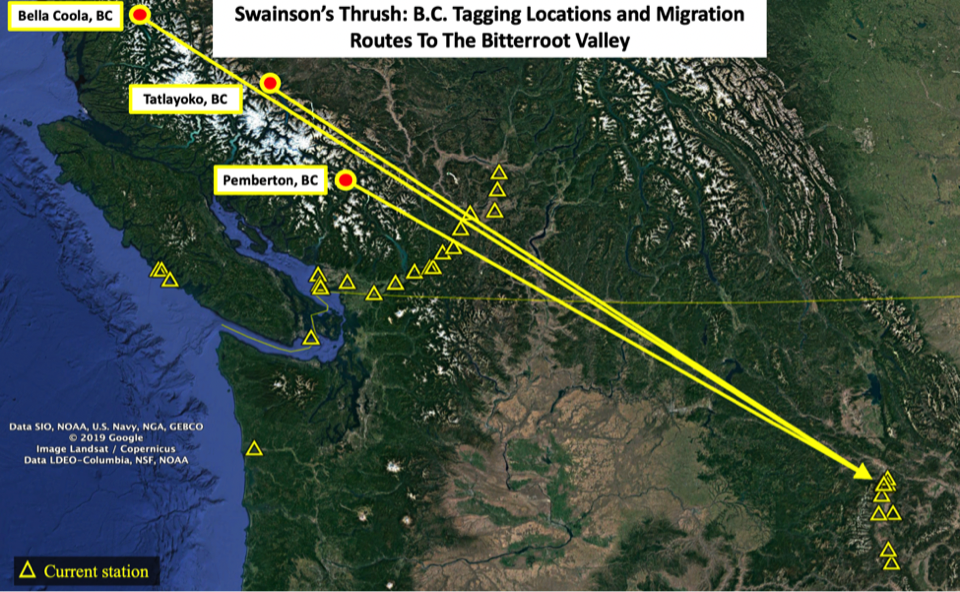
Tracking Wildlife Migration With Motus
Block title
Avian Ecology
We seek to understand how birds use the habitats available and how that will change as we work to create more diverse plant communities. We also host researchers that document migrations of raptors and songbirds across MPG.
In this section of the research pages, you will find links to reports and updates from all the researchers involved with avian ecology, posted chronologically. The links will show you more in-depth reports on our findings. The three main projects covered here are:
Songbird Counts- A grid of sampling points covers MPG with 560 points. We visit each point 3 times a year, once in winter and twice during the songbird breeding season. We record, by ear or by sight, all the birds near that point for 10 minutes.
Songbird Banding- The University of Montana Bird Ecology Lab, UMBEL, runs several trapping stations at MPG as part of their regional songbird monitoring program. UMBEL sets up very fine nets that are nearly invisible to birds in brushy habitats. Songbirds fly into the nets and become entangled. The researchers take the birds from the nets and affix a numbered band to their leg before releasing them.
Raptor Research- The Raptor View Research Institute monitors raptor populations on MPG and counts raptors that migrate past MPG in the spring and fall. Raptor View researchers have placed transmitters on osprey and golden eagles that use the Bitterroot Valley.
The map shows current Motus stations in North America.
In 2018, MPG Ranch and collaborators initiated the “Intermountain West Collaboration” (IWC) Motus project. Our goals are to expand the network in the west to piece together the migration behavior of regional wildlife. Last year, IWC partners led several pilot projects on MPG Ranch to assess Motus’s capabilities in tracking focal bird and bat species. In total, we tagged 93 birds and 14 bats, and we installed a local network of 11 Motus stations across the Bitterroot Valley, MT (see Motus 2019 Summer Update).
Despite low numbers of Motus stations in western North America, we already have exciting bird detections from the 2019 fall migration.
Researchers from the Bird Ecology Lab and the Breuner Lab at the University of Montana tagged several songbird species, including gray catbirds at MPG Ranch. Two of these catbirds migrated by a series of Motus stations in the Gulf Coast of Texas (map below). The Gulf Coast funnels most gray catbirds from the eastern U.S. before they migrate south to winter in Mexico and Central America.
Meanwhile, we detected some “external” tags, which are birds not tagged by our IWC partners. Our Bitterroot Valley array picked up eight Swainson’s thrushes tagged in British Columbia by Dr. Kira Delmore and her team. Like the gray catbirds from MPG Ranch, these thrushes appeared to migrate easterly into the Midwest before taking a more southerly trajectory (see an animation of Motus tracks). Our IWC network can help The Delmore Lab learn where these thrushes travel over the Rocky Mountains.
Although we do not know the exact migration routes in-between Motus stations, our IWC Motus network in western Montana is already contributing to new information on bird migration. Our IWC project will provide opportunities to develop research studies that account for species’ complete annual cycles.
We will continue sharing these new observations and developments from our IWC Motus project as we analyze more detection data and await the return of tagged birds during spring migration.
Motus Acknowledgements
Kira Delmore, Texas A&M University, Motus “Thrushes” Project.
Susan Heath, Gulf Coast Bird Observatory, Motus “Western Gulf Avian Resource Assessment” Project.
Intermountain West Collaboration Project researchers; https://motus.org/data/project?id=213.
Motus Data
MPG Ranch. 2019. Intermountain West Collaboration Project. Data accessed from the Motus Wildlife Tracking System. Bird Studies Canada. Available: http://www.motus-wts.org/. Accessed: 27 December 2019.
Motus Map
Bird Studies Canada. 2019. Motus Wildlife Tracking System. Port Rowan, Ontario. Available: http://www.motus-wts.org. Accessed: 27 December 2019.























